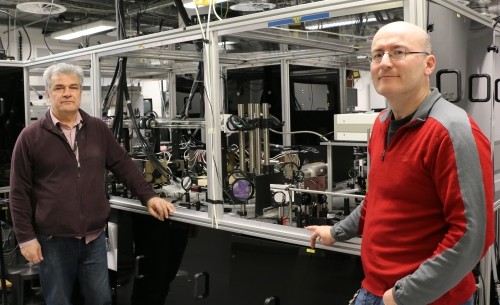
Gods of thunder: Gagik Nersisyan (left) and Matt Zepf at the TARANIS laser facility.
By Hamish Johnston
I recently had the pleasure of visiting Matt Zepf, who directs the Centre for Plasma Physics at Queen’s University Belfast. Zepf and his colleague Gagik Nersisyan showed me around the TARANIS laser facility, which creates extremely bright flashes of light just like its namesake the Celtic god of thunder.
TARANIS is about to upgraded to TARANIS-X, which will deliver ultrashort pulses of extreme ultraviolet light (EUV) that are just a few attoseconds (10–18 s) in duration. Each attosecond pulse will deliver more than 10 µJ, which Zepf says will make TARANIS-X the most powerful laser of its kind by a comfortable margin.
These pulses will be extremely useful to scientists because chemical reactions tend to occur on attosecond timescales. A key feature of the facility is that it will be able to do “pump–probe” experiments in which the pump pulse (which initiates a change in the sample) and the probe pulse (which measures the result of the change) are both of attosecond duration. Previously this had not been possible for the pump pulse, which must deliver a relatively large amount of energy to the sample.
The new facility will also deliver femtosecond EUV pulses with energies in excess of 100 µJ, which Zepf says will make TARANIS-X competitive with the brightest free-electron laser facilities operating today.
The new equipment will be delivered in March and the team hopes to have TARANIS-X up and running by 2017. One of its first uses will be the study of the excited states of helium atoms. The attosecond pulses will then be used to investigate increasing complex atomic and molecular systems.
TARANIS can already deliver femtosecond laser pulses at powers of a few hundred terawatts and is being used in a number of different fields, including the study of “warm dense matter”. This stuff is created when a target is blasted by an extremely intense laser pulse and this type of matter is of great interest to astronomers because it is believed to form the cores of gas-giant planets such as Jupiter and Saturn as well as many of the recently discovered exoplanets that orbit distant stars.
Much closer to home, TARANIS is also used to create pulses of high-energy protons that are similar in energy to those used in cancer therapy. Scientists can then observe how these protons deposit energy in target materials on very short timescales. This provides medical physicists with important information about how to use proton beams to destroy tumours while minimizing the damage to surrounding healthy tissues.
Guidelines
Show/hide formatting guidelines
this text was deletedwhere people live in harmony with nature and animals</q>
Some text